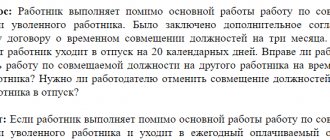What is registration according to the Labor Code of the Russian Federation
Today, the Labor Code of the Russian Federation establishes a clear sequence of actions that the parties must perform in order for the labor relationship to be officially recorded. The basic principles of labor law are also recorded. It is worth highlighting the following basic points:
- registration of labor relations is carried out voluntarily. No one has the right to force a citizen to do work that he does not like;
- forced labor is prohibited. Any discrimination in the field of labor relations is also prohibited;
- the state helps citizens find employment and takes measures to eliminate unemployment;
- each work must be paid in an amount no less than that established at the state level;
- The relationship between the employer and the citizen being hired must be contractual. Stons initially clearly know the boundaries of their rights and powers, the violation of which may result in legal liability.
Based on the listed principles, the beginning of the employment procedure provides for a certain sequence of actions included in the Labor Code of the Russian Federation. This included:
- Writing an application for employment.
- Issuance of an order to enroll the company's employees.
- Signing of an employment contract by the parties.
- Familiarization of the new employee with job and work instructions, legislation, regulations, regulating issues in the field of activity of a particular employee.
Remember, registration under the Labor Code of the Russian Federation is a clear fixation of the relationship between the administration and the citizen regarding the performance of a specific type of work in accordance with the current rules of labor legislation.
How can you formalize your relationship with an employee?
Labor relations are only those relations between employer and employee that have the characteristics specified in Article 15 of the Labor Code of the Russian Federation :
- work according to the position in accordance with the staffing table, profession, specialty indicating qualifications;
- the specific type of work assigned to the employee (labor function);
- subordination of the employee to internal labor regulations;
- provision by the employer of working conditions provided for by labor legislation and other regulatory legal acts containing labor law norms.
But in addition to labor relations based on an employment contract, interaction with an employee can also be formalized within the framework of civil law relations, when the employer and employee act as a customer and performer. Such relationships are not subject to labor laws and relieve the customer of a significant share of responsibility for the working conditions of the contractor. At the same time, Article 15 of the Labor Code of the Russian Federation emphasizes that the conclusion of civil contracts that actually regulate labor relations between an employee and an employer is not allowed.
The most frequent complaints from regulatory authorities are precisely the attempt to present real labor relations under the guise of civil law. What does the employer gain in this case? He not only has the opportunity not to pay insurance premiums for injuries and occupational diseases for the employee to the Social Insurance Fund, but also does not have to provide vacation, sick leave, maternity payments and dismissal benefits. But if the employer wins here, then the employee loses, therefore, from January 1, 2014, he has the right to demand that civil law relations be recognized as labor relations (Article 19.1 of the Labor Code of the Russian Federation), if there are real grounds for this.
We propose to take a closer look at how the interaction between employer and employee is structured within the framework of labor relations itself and within the framework of civil law, among which there is also the option of agency labor (staff leasing).
Payroll and personnel records
Hiring procedure
Registration of employment is carried out in several stages. They can be grouped into separate blocks:
- Preparation of documents . The legislator has outlined an exhaustive list of documents required for employment. This included a passport, identification code, military ID, insurance certificate, work book, education document (if the position requires certain qualifications), medical certificates of health (also when the position provides for certain criteria for the health of the applicant).
- Introductory stage . Usually carried out in the form of an interview with the employer (his representative). The purpose of communication is to familiarize the future employee with working conditions, payment, and social guarantees. His duties, rights, responsibilities. At this stage, the citizen decides for himself whether he agrees to such working conditions.
- Employment registration stage . In this case, an application for employment is written, an order for hiring is prepared and signed by the employer, and the parties sign an agreement. The employee is officially introduced to the labor regulations, collective agreement, job and work instructions.
- Registration of the employee by the personnel and accounting department . Occurs without the participation of the employee. At this stage, a personal file is opened, an account is opened in the accounting department, a bank card is issued, and the workplace is prepared to be able to fully perform the functions assigned to it.
Remember, if you have a full package of necessary documents, the employment procedure takes no more than one working day. This day is considered a working day and is paid in full.
What documents are required
At the time of employment, the employer has the right to require a clearly defined list of documents from the future employee. Let's look at what documents are included in this list and under what circumstances does the employer have the right to demand this:
- Passport. Provided in all cases. It is a basic identification document.
- TIN. Served along with your passport. Necessary for the correct calculation of taxes for a specific individual.
- Employment history. Attached to the documents if available. If it’s missing, the company will start a new one after employment. The document is not required to be presented.
- Military ID (registration certificate). Applies to male persons liable for military service (they may also be required for some female positions. For example, for certain categories of doctors).
- Insurance pension certificate. Required for people who have previously worked. If such a document does not exist, it must be created on site. At the same time, the citizen himself must be interested in this document, because the size of the pension will depend on pension contributions in the future.
- Certificate of no criminal record. It may only be required if the future work is related to finance or the need to keep some state or commercial secrets.
- Certificate of passing a medical commission. It is required only if the future work is related to the need to be in a certain physical form (vision, hearing, speech, reaction, the ability to work in certain conditions).
Remember, the employer is prohibited from requiring any additional documents not provided for by law. Especially if this concerns the personal life of a citizen, his party preferences, beliefs, skin color, gender and others.
Signing an employment contract
At every enterprise, regardless of the type of ownership, an agreement is concluded between the employee and his employer. The absence of such a document is fraught with penalties against the employer. Therefore, the administration is directly interested in the timely preparation of such documents. Moreover, in most cases, there are already templates for such contracts for each position in order to speed up the employment procedure.
This document contains information:
- list of worker responsibilities;
- the place of work, work and rest schedule, and basic conditions of remuneration are specified;
- liability of the parties for failure to comply with the terms of this agreement;
- separate norms (in a condensed form) of local documents regulating labor duties, social protection, guarantees, compensation, and other important points for the employee.
An employment contract is signed by the employer and employee. Labor legislation does not provide for other signatories or approvals.
How is the operating mode interpreted?
Working time itself is the period during which an employee must perform his assigned duties. An employee must strictly follow the rules of the organization where he is employed.
Working hours - distribution of working hours within a day or other calendar period.
https://dic.academic.ru/dic.nsf/business/11347

Any organization has a working time schedule for employees.
Mode elements
The labor regime includes several components:
- length of shift or working day;
- time for rest during the shift;
- hours of work per week;
- rest between shifts;
- legal holidays.
The legislative framework of our country, in particular the Labor Code of the Russian Federation, provides for the maximum duration of the above elements. And also the length of the working day is additionally fixed in employment contracts. The labor regime differs for workers in different fields, i.e. it directly depends on the specifics of the organization and the industry in which this organization is involved. The differences are contained in the agreement between the employer and the employee. Most often, a standard schedule is used, which involves a five-day work week of 8 hour shifts. In those enterprises where it is important to ensure a continuous work process, a shift schedule is practiced, as well as total time tracking for a certain period.
What are the working hours?
According to the Labor Code of the Russian Federation, there are several types of labor regime:
- standard (normalized);
- irregular;
- flexible;
- removable;
- shift worker;
- fragmented;
- incomplete or abbreviated.

The legislation of the Russian Federation provides for several types of operating modes
Standard schedule
The normal schedule involves working 40 hours per week. This period does not depend on how many days a week the employee works. If an employee works 5 days a week, then he must be given 2 days to rest. In this case, the working day will be equal to 8 hours. If the work week lasts 6 days with 1 day for rest, then the working day will be 7 hours. It is worth considering that the day before the weekend in this case is considered shortened and lasts 5 hours. The standard work schedule is the most common and, as practice shows, is most often used by employers (especially government agencies and service companies).
Irregular schedule
The legislation of our country does not stipulate how many hours constitute an irregular day. In some cases, an employee works more than 40 hours a week, but only by prior agreement between him and the employer. In this case, processing cannot last more than 4 hours in 2 days (consecutive) and 120 hours in a calendar year. An employee may spend not only a regular working day performing his duties, but also the time before or after it. Such a work schedule is short-term in nature, i.e. it is used by management only from time to time, but the employee does not have the right to refuse to carry it out (if this activity does not contradict the responsibilities specified in the employment contract). An irregular schedule implies a further increase in the employee’s vacation.

An irregular schedule can harm an employee’s health, so constant work in such a mode is unacceptable
Flexible schedule
A sliding schedule differs from a regular schedule in that a specialist has the right to independently determine the beginning and end of his working day. The above-mentioned work regime is typical for workers in creative professions; it is encouraged by managers to obtain maximum results.
A flexible work schedule is convenient for those enterprises that, due to their specific nature, have active and passive periods of activity during a standard shift, and which seek to evenly distribute the load by introducing such a schedule.
Shift work
At enterprises, it is important to ensure a continuous production process, and therefore a shift mode is practiced. According to this method, work shifts are evenly distributed among personnel, which is reflected in shift schedules. Employees must familiarize themselves with the shift schedule in advance (at least a month before the document comes into effect). According to legislation, the same employee must have sufficient rest between shifts. An employee’s schedule cannot include two shifts in a row, otherwise this would be a violation of labor laws. There are 3 shifts in total:
- daytime;
- evening;
- night
The number of hours in a shift work schedule, if the work week consists of 5 days, will be equal to 8 hours. Night work is different from day work; it involves shortening the shift by one hour. But there are employees whose night shifts should not be reduced. These are people specifically hired to work only at night, as well as those who already work on a reduced schedule. The Labor Code of the Russian Federation provides for categories of people who should not work on the night shift, among them:
- minors (exceptions are considered in the legislation);
- disabled people;
- pregnant women or those with children under three years of age (full list in the Labor Code of the Russian Federation).

The shift schedule should ensure an even workload for workers and sufficient rest to recuperate.
Fractured schedule
With the consent of the employee, a fragmented schedule can be used, when the working day is divided into parts. This is justified in cases where there is unequal intensity of the labor process. But even with a fragmented schedule, the employee must fully fulfill the range of responsibilities assigned to him by the employer and reflected in the employment contract.
Shift method
A shift includes not only time allotted for work, but also rest between shifts. In this case, the employee works in shifts, but unlike the shift schedule, it is assumed that the place of work is remote from the place of residence (different cities). The shift lasts, as a rule, no more than a month, after its completion the workers go home. Sometimes the duration of the shift increases to three months. Examples of shift work include construction teams or various types of crafts. The time spent on the road is included in the watch. Shifts in this case last more than 8 hours (up to 12). There are categories of people who cannot work using this method. Among them:
- minors;
- pregnant women and women with children under three years of age;
- persons who have contraindications for performing work on a rotational basis.

Only workers who do not have health problems can be recruited to work on a rotational basis.
Part-time work
An employee can work less than 8 hours a day, but only if there is agreement between him and the employer on this matter, reflected in the employment contract. Such a schedule can be valid for a certain period or indefinitely. It is understood that the employee’s salary will be directly proportional to the results of work and the time spent on it. Part-time work is often introduced for pregnant women; its duration is agreed with the employer. In addition, the working day may be shortened for other employees.
Table: abbreviated schedule
| Categories of workers | Time spent working |
| Children (from 14 to 16 years old) | 24 hour work week |
| Teenagers (16 to 18 years old) | The norm increases to 35 hours per week |
| Disabled people (groups 1 and 2) | no more than 35 hours per week |
Video: shift work schedule
Right to rest
Another important element of the work regime is the time allotted for rest. The Labor Code of the Russian Federation confirms that every employee has the right to the following types of rest:
- lunch break or heating time (from 30 minutes to 2 hours);
- rest between shifts (each enterprise has its own);
- weekly rest (at least 42 hours).
Employment history
This is the main document confirming the employee’s length of service and work activity. Has a standardized form. Conducted according to government-approved methodology. It is compiled for each worker individually.
The work book displays the following data:
- name of the employer's company;
- date of employment (dismissal);
- full name of the position to which the employee was assigned (transferred);
- date and number of the order on the basis of which the enrollment (dismissal) was made;
- incentives available to the employee.
All records are certified by the signature (with a transcript of the position name and full name) of the employee authorized to maintain work records, as well as the company seal. The absence of these details may cause the entries to be invalidated.
According to the rules for maintaining work books, all entries are entered sequentially and numbered in continuous numbers. If you change place of work, maintaining the work book continues at the new place of work. For the entire period that an employee is on the company’s staff, his work record book must be kept in the HR department. Handing over this document to the worker is not allowed.
Remember, the absence of a work record is not a basis for refusal of employment. But in this case, the length of service will begin from the moment of the last employment. And this means a reduced amount of sick leave and other social benefits.
Probation
To check the suitability of an employee for the position to which he is appointed, the employer may establish a probationary period. This must be stated in the employment contract. The conditions and duration of the test are established. If there are no such formulations initially, then the citizen should be considered as having been accepted on a permanent basis.
The maximum probationary period for workers is three months. For economic, engineering, and management employees, the test period can be up to 6 months. If the employment contract is concluded for a period of no more than six months, the trial period should be no more than two weeks. After the end of this period, if the employee has not been dismissed, he should be considered to have passed the test.
But there are categories of citizens for whom tests are not established. This list included:
- minors (under 18 years of age);
- pregnant women, as well as mothers with children under one and a half years of age;
- persons who have passed the preliminary competition for appointment to this position;
- university graduates in the field of study;
- citizens elected to office;
- if employment is carried out by transfer;
- when the term of the employment contract is less than 2 months;
- in other cases provided for by law.
Remember, in order to dismiss an employee at the end of the probationary period, it is necessary to prove that he really did not pass the test. Otherwise, he will be able to challenge this and be reinstated in his position on an indefinite basis.
Applying for a job by transfer from an organization
Article 72.1 of the Labor Code
provides for the possibility of hiring by transfer from other enterprises. This procedure is somewhat different from the one described above in that three parties take part in the process of enrolling an employee in a position: the current employer, a potentially new one, and the citizen himself.
The procedure is initiated through an invitation to employment from a new organization. Next, the citizen submits a request for transfer, after which the current manager issues documentary consent or refuses the transfer.
You may be interested in: Dismissal due to transfer to another organization
If the initiator of the transfer is the citizen’s current employer, then in order to successfully complete the procedure, his manager must obtain consent to the change of job from the employee himself.
Features of employment of certain categories of employees
During the hiring process, not all employees are processed the same way. There are some exceptions to the general rule. They concern the following categories of hired workers:
- Minor employee. The peculiarity of the employment of such a citizen is that he does not have the right to set a probationary period. In some cases, written parental consent is required for such a citizen to begin performing labor functions. A medical examination with conclusions about the suitability of future work is mandatory here.
- Foreign worker. To hire such a worker, you will need to obtain special permission from the state for his employment. Issued for a specific period (usually up to 3 years). It may be further extended. Therefore, the employment contract is concluded for the same period.
- Part-time work. Provides the opportunity to work two jobs simultaneously. In this case, the work book is kept at the main place of work. Working time at the main place of work must be at least 50% of the total working time. If a citizen works two jobs where the time does not overlap (for example, one during the day and the other during night shifts), this is not considered part-time work. It is issued (except for the work book) at both places of work.
- Nuances of registering as a remote employee. The main nuance is that you don’t have to go to the HR department with documents. All you need to do is scan them and send them by email. In the future, you can get certified copies by regular mail. You will also receive an employment contract signed by the employer. All further correspondence and communication, including delivery of completed work, is carried out remotely via the Internet.
Remember, the legislator clearly regulated the nuances of formalizing labor relations with various categories of citizens. Therefore, before starting cooperation, it is advisable to familiarize yourself with them in advance.
What is official employment?
Official employment is a type of legal transaction between citizens, which is based on four main aspects:
- A written contract with a certain period of validity is concluded between the employer and the hired person performing his direct or indirect instructions. This document specifies the employee’s salary, his main responsibilities and additional circumstances under which the boss may deviate from the requirements of the Labor Code of the Russian Federation. For early termination of the said act, both parties will bear responsibility as provided for in the administrative code;
- Having hired a new employee, the manager is obliged to establish a shift schedule for him and ensure timely deductions from his salary to state funds (PFR, Social Insurance Fund and Compulsory Medical Insurance Fund). Also, the subordinate must be provided with a work book designed to record all his movements along the career ladder and changes in jobs (for citizens who have drawn up a part-time agreement, this document is not needed);
- Before starting to perform official duties, a citizen must provide his supervisor with a complete package of documents, which includes: passport, TIN, extract from a medical examination, diploma of education and, if necessary, additional certificates (driver’s license, certificate from a psychiatrist, etc.). d.);
- Only the employer, subordinate or judicial authority can terminate an employment contract. Other persons and structures do not have such powers. The very severance of relations between an employee and superiors, at the initiative of either party, must occur in writing with subsequent recording in the work book.
Attention! If at least one of the listed points is not observed, then such a transaction cannot be called official employment. This means that the Labor Code of the Russian Federation does not apply to it.
Legislative regulation
The main legislative act of the Russian Federation is the constitution. Based on its canons, the Labor Code cannot establish rules for workers that contradict the following principles:
- Labor can only be voluntary (no manager has the right to force employees to carry out his instructions or prohibit them from resigning of their own free will);
- Working conditions must be decent and not infringe on human development (the Labor Code of the Russian Federation provides for additional leaves for students, the state finances advanced training for subordinates, etc.);
- Citizens who choose self-employment have the same right to receive social assistance as people working for someone under an employment contract (this includes lawyers, tutors, private entrepreneurs, etc.);
- Persons with a special status (disabled people, military personnel, families with many children, guardians, etc.) receive benefits when officially employed (this may include an increase in salary, additional leave, tax exemption and other privileges).
But if a person is not officially employed, then compliance with the listed duties by the employer is not guaranteed.

Social guarantees
For citizens with official employment, the state provides a specific list of services, the implementation of which is controlled by the current legislation of the Russian Federation. This includes:
- Fixed salary paid on time;
- 28 days of compulsory rest per year;
- Increased pension (persons who make contributions to the Pension Fund throughout their life can count on a higher benefit than non-officially employed people who evade monthly fees);
- Social benefits intended for veterans, disabled people, breadwinners of large families, pregnant women and subordinates under 16 years of age;
- Full protection, in accordance with the Labor and Administrative Codes, as well as the Federal Law of the Russian Federation (if the listed acts are violated by the manager, subordinates have the right to file a claim in court).
It is important to know! It is worth noting that for an ordinary citizen, in accordance with the Labor Code of the Russian Federation, official employment is not mandatory. But employers cannot hire new employees without the appropriate registration, as this is considered a violation of the Tax Code.








